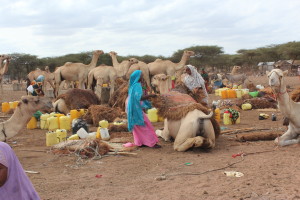A drought is an extended period of deficiency in water — either surface or underground. Drought is a normal, recurrent feature or climate. It occurs almost everywhere, although the features vary, depending on location. Defining drough t is therefore difficult. It depends on differences in regions, needs, and perspective. A lack of water in Vietnam is a very different event from a lack of water in, say, Mali. A drought can last for months or years, or may be declared after a couple of weeks. Although droughts can persist for several years, even a short, intense drought can cause significant harm to a local or national economy.
t is therefore difficult. It depends on differences in regions, needs, and perspective. A lack of water in Vietnam is a very different event from a lack of water in, say, Mali. A drought can last for months or years, or may be declared after a couple of weeks. Although droughts can persist for several years, even a short, intense drought can cause significant harm to a local or national economy.
Drought is considered a ‘slow-onset’ disaster. Unlike a flood or a wildfire, it is not a distinct, ‘quick-onset’ event and often has no well-defined start nor end. Drought is often the result of many complex factors. Generally, it occurs when a region receives consistently below average precipitation. It can have a substantial impact on the ecosystem and agriculture in the affected region. Lengthy periods of drought have long been a key trigger for mass migration and played a key role in a number of ongoing migrations and other humanitarian crises in locations such as the Horn of Africa or the Sahel.
Periods of droughts can have significant cons equences — environmental, agricultural, health, economic and social. The effect varies according to vulnerability. For example, subsistence farmers are more likely to migrate during drought because they do not have alternative food sources. The “dust bowl” of the 1930s in the US Midwest literally changed the face of the nation, with massive western migration, primarily into California. Areas where populations depend on a staple food which is grown in a local farming setting are more vulnerable to famine. Developed countries are not immune, as witnessed this decade by the economic impact of an extensive, multi-year drought in Australia.
equences — environmental, agricultural, health, economic and social. The effect varies according to vulnerability. For example, subsistence farmers are more likely to migrate during drought because they do not have alternative food sources. The “dust bowl” of the 1930s in the US Midwest literally changed the face of the nation, with massive western migration, primarily into California. Areas where populations depend on a staple food which is grown in a local farming setting are more vulnerable to famine. Developed countries are not immune, as witnessed this decade by the economic impact of an extensive, multi-year drought in Australia.
Internationally, drought is often an element in what is known as ‘complex disasters’. I served in Ethiopia during part of the 1984-85 famine and saw widespread suffering and mortality. The tragic famine was blamed on natural factors — a lack of rain — and the outpouring of humanitarian aid was enormous. However, upon closer examination, research reveals a complex mix of factors. These include: government agricultural policies that caused a ‘disincentive’ for farmers to grow more than for personal consumption; export / import policies which depleted the national ‘grain bank’ that buffers against poor harvests; insufficient transport systems to move crops from a surplus region to a deficit region; ethnic fav oritism; and poor rainfall patterns. Drought was actually a minor factor in Ethiopia’s 1984-85 famine.
oritism; and poor rainfall patterns. Drought was actually a minor factor in Ethiopia’s 1984-85 famine.
Drought also can reduce water quality, because lower water flows can increase the concentration of contaminants and reduce the dilution of various pollutants. Some other common consequences of drought not mentioned above include a) Diminished crop growth, yield production, and carrying capacity for livestock; b) Dust bowls and storms, when drought hits an area suffering from desertification and erosion; c) lack of water for irrigation; d) Habitat damage, affecting both terrestrial and aquatic wildlife; e) Malnutrition, death, or dehydration and related diseases; and, f) Reduced electricity production due to reduced water flow through hydroelectric dams.
The causes of droug ht are complicated, and researchers carefully study hydrological models, natural cycles, and climatic variations. Also recognized is that human activity can negatively impact the ability of the land to capture and hold water, such as by over farming, excessive irrigation, deforestation, and erosion. These tend to be relatively isolated in their scope. However, activities that increase risk factors which impact global climate change that may trigger droughts can have a substantial and widespread impact on agriculture, commerce, and human health throughout the world.
ht are complicated, and researchers carefully study hydrological models, natural cycles, and climatic variations. Also recognized is that human activity can negatively impact the ability of the land to capture and hold water, such as by over farming, excessive irrigation, deforestation, and erosion. These tend to be relatively isolated in their scope. However, activities that increase risk factors which impact global climate change that may trigger droughts can have a substantial and widespread impact on agriculture, commerce, and human health throughout the world.
Thanks for reading.
Leave a Reply
You must be logged in to post a comment.